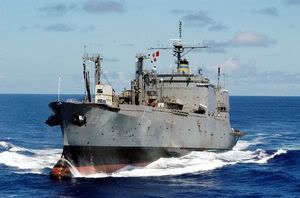SINGAPORE, May 15, 2007 - Navy News Service
(By Edward Baxter, Sealift Logistics Command Far East Public Affairs)

Civil service mariners aboard Military Sealift Command ammunition ship USNS Shasta T-AE 33 rescued all crew members aboard a disabled commercial cargo ship May 12 in the Western Pacific near Saipan.
Just after sunset, Shasta received a request from the U.S. Navy’s 7th Fleet Battle Watch Center to assist the ill-fated MV Haurosi, which reported a major engine room fire.
Traveling at full-speed, Shasta made the 90-mile voyage to Haurosi’s location in just over four hours, using the transit time to prepare the flight deck for helicopter operations and ready Shasta’s towing and firefighting equipment.
“As we approached, we could see the crew on deck waving flashlights,” said Capt. R.J. Bellfi, Shasta’s civil service master. After refueling a U.S. Navy HH-60 helicopter from Guam that was already on-scene, Shasta’s crew dispatched a boarding team to Haurosi in the ship’s rigid-hull, inflatable boat.
Once on board Haurosi, Cargo Officer Robert Foor assessed the damage to the ship and condition of the crew. The fire was fully extinguished, but Haurosi was adrift without propulsion or power. Luckily, the ship’s crew fared much better.
“They were a bit exhausted, but appeared to be in good shape,” Foor said. Haurosi and its crew were five days into a voyage from Pusan to the Solomon Islands when the fire occurred.
Shasta set up temporary lighting to monitor the ship throughout the night. The following morning, in rain showers and gusty winds, Shasta attached a tow line to Haurosi and set course for Saipan, the nearest port.
“We had a lot of rigging to accomplish to get the towing bridle aboard and in place,” said Boatswain's Mate Ronald Hanses, one of the key players in the boarding team. “Without mechanical power, it was a tough job pulling a towing rig from one ship to another. It helps to have that knack for improvising.”
All five Haurosi crew members were transferred to Shasta and received general medical services, a hot meal, clean clothing and a place to sleep. Shasta’s crew passed the hat and collected $800 for Haurosi’s crew, all citizens of the Solomon islands.
Shasta safely delivered Haurosi and its crew to Saipan. “We were well-equipped and had the seamanship experience to provide assistance for this rescue,” said Bellfi. “There is a support network out there, always on watch, and we are part of it.”
The 564-foot, 20,000-ton Shasta is one of MSC’s five ammunition ships and is one of 39 ships in the Naval Fleet Auxiliary Force program that provide logistics support to U.S. Navy warships operating in the Western Pacific and Indian Oceans. The ship has a crew of 134 civil service mariners employed by MSC as well as two military personnel.
MSC operates approximately 110 noncombatant, civilian-crewed ships that replenish U.S. Navy ships, chart ocean bottoms, conduct undersea surveillance, strategically preposition combat cargo at sea around the world and move military cargo and supplies used by deployed U.S. forces.

